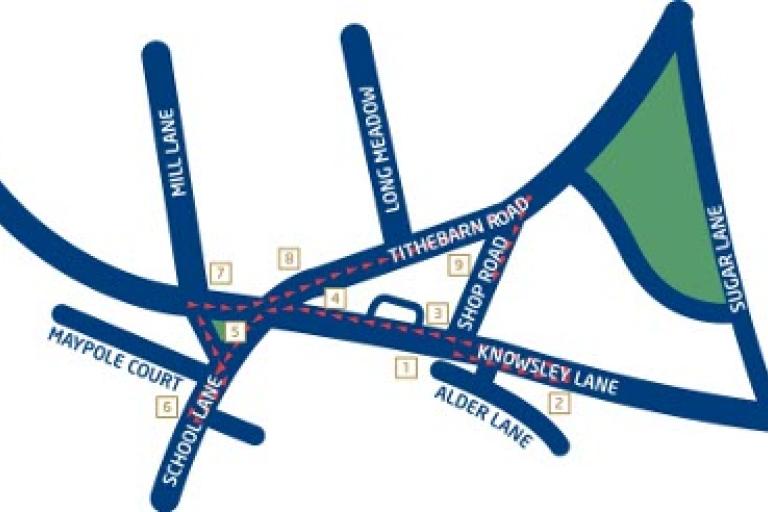Knowsley Village
Knowsley Village, once owned by the Earls of Derby, is documented in the Domesday Book of 1086 and considered one of the best village cores in Merseyside.
Today, it is still predominantly rural and retains a character reminiscent of pre-war England. Knowsley Village conservation area, designated in the 1970s, is typical of a historic village with a village green at its centre. The parish church, village hall, school, the Derby Arms hotel, and the estate workers' houses indicate the influence of the Earls of Derby. Since the Second World War, several housing estates have been built to accommodate the growing population.

The route:
- The Derby Arms was built in 1900, and the first tenant was James Hornby. It bears the crest of the Stanley family, the Eagle and Child, and the motto of ‘Sans Changer’, meaning ‘Without Change’.
- After passing the Old Post Office, which opened in 1895, you come to the almshouses, originally named Countess Mary’s Bungalows. They were built in 1883 for retired estate workers, who had rules to abide by and were issued with a uniform to wear! Note the plaque in memory of Frederick Arthur, the 16th Earl of Derby.
- The village shop is typical of many of the buildings in Knowsley. It was built in the 1880s from local brick and sandstone. The slate roof tiles are also a typical feature.
- The Grade II listed church of St. Mary the Virgin was built in 1844 by Edmund Sharpe of Lancaster, with the Derby Memorial Chapel, designed by E.G. Paley, being added in 1871. Paid for by the 13th Earl of Derby for £20,000, the church was added to by the later Earls. Its lavish furniture and fittings reflect the great wealth of the benefactors.
- Around the picturesque village green, also known as Maypole Green, you can see a variety of buildings, including the village hall built in 1897. The village hall is still active, hosting meetings and exhibitions. The Memorial Cross commemorates the men lost in the First World War, and the village green may have been the site of the smithy of William Woods in the 1780s.
- Along School Lane are some of the oldest buildings in the village, including Maypole Farm, which dates from 1772. The cottages and farms were once the homes of the Earls of Derby’s estate workers.
- The School House, now Millbrook Restaurant, was built in 1845 by the 13th Earl of Derby. The first school mentioned in Knowsley was founded by Margaret Beaufort, who was the second wife of the first Earl.
- Walking along Tithebarn Road, you will see some of the finest houses in the village. Knowsley Vicarage was built around 1885 and is Grade II listed. It is constructed in red brick, terracotta and sandstone. Many of the local houses built at the same period share characteristics of the vicarage, including tall chimneys and jettied windows. Further down are the housing developments of the 1960s and 70s.
- Shop Road includes both 19th-century and more recent buildings, one of which stands on the site of Knowsley Village Clubhouse and bears a plaque to reflect that history.